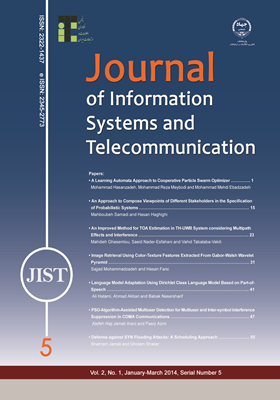-
-
List of Articles
-
Open Access Article
1 - A Learning Automata Approach to Cooperative Particle Swarm Optimizer
Mohammad Hasanzadeh meybodi meybodi mohamad mehdi ebadzade -
Open Access Article
2 - An Approach to Compose Viewpoints of Different Stakeholders in the Specification of Probabilistic Systems
Mahboubeh Samadi haghighi haghighi -
Open Access Article
3 - An Improved Method for TOA Estimation in TH-UWB System considering Multipath Effects and Interference
Mahdieh Ghasemlou Saeid Nader Esfahani Vahid Tabataba Vakili -
Open Access Article
4 - Image Retrieval Using Color-Texture Features Extracted From Gabor-Walsh Wavelet Pyramid
Sajad Mohammadzadeh Hassan Farsi -
Open Access Article
5 - Language Model Adaptation Using Dirichlet Class Language Model Based on Part-of-Speech
Ali Hatami Ahmad akbari Babak Nasersharif -
Open Access Article
6 - PSO-Algorithm-Assisted Multiuser Detection for Multiuser and Inter-symbol Interference Suppression in CDMA Communications
Atefeh Haji Jamali Arani paeez azmi -
Open Access Article
7 - Defense against SYN Flooding Attacks: A Scheduling Approach
Shahram Jamali Gholam Shaker
-
The rights to this website are owned by the Raimag Press Management System.
Copyright © 2017-2025







